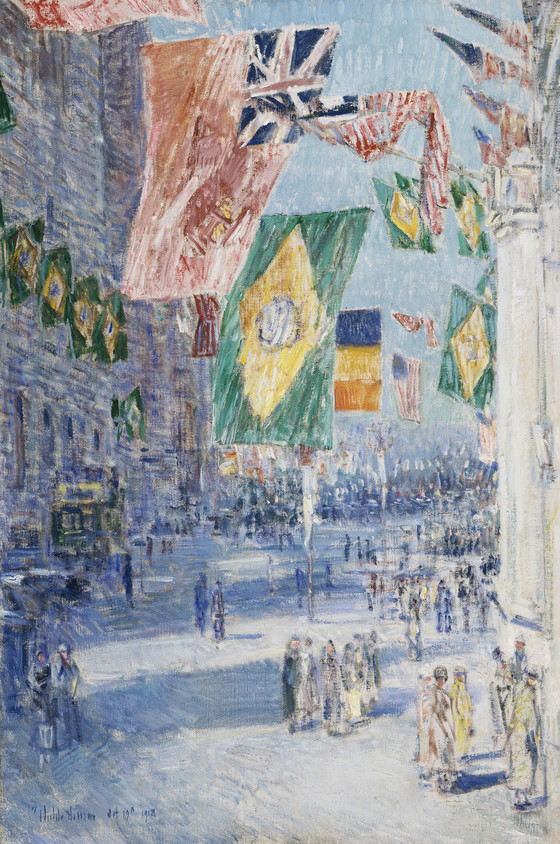The Preparedness Parade down Fifth Avenue in New York on May 13, 1916, demonstrated America’s readiness to fight in World War I and kindled Hassam’s patriotic fervor, prompting him to begin his famous...
The Preparedness Parade down Fifth Avenue in New York on May 13, 1916, demonstrated America’s readiness to fight in World War I and kindled Hassam’s patriotic fervor, prompting him to begin his famous series of flag paintings. By the end of the war he would create approximately thirty oil paintings of New York bedecked with displays of banners and flags as part of the home-front effort to inspire patriotism and help raise funds for war relief efforts. Fifth Avenue was often decorated, and for the Fourth Liberty Loan Drive in the autumn of 1918 it became known as the Avenue of the Allies, each block from Twenty-fourth to Fifty-eighth streets being devoted to the flags of a particular Allied country.
Hassam painted five pictures of Fifth Avenue during this celebration. In the museum’s version the artist depicted the block between Fifty-fourth and Fifty-fifth streets, on which Brazil was represented. The flag of that country, a yellow diamond on a ground of bright green with a blue orb in the center, appears not only as the large flag waving in the center of the composition but also directly to the right and in a large grouping of flags to the left. The block south of Brazil was devoted to the British Empire and the one north to Belgium, so Hassam shows the New Zealand flag flying in the foreground and the flag of Belgium, a threebanded design with black on the top (Hassam always used dark blue), yellow in the center, and red on the bottom, flying behind the flag of Brazil. The flag of the United States also appears several times, hanging from buildings and in the distance across the thoroughfare. The painting closest to this one is Avenue of the Allies, Great Britain, 1918 (Metropolitan Museum of Art, New York), in which Hassam depicted almost the same section of Fifth Avenue looking uptown but from the west side of the street rather than the east, so that the configuration of flags appears slightly different. The two versions share Hassam’s use of architectural components -- tall, sheetlike buildings -- on both sides of the picture to frame the flag scene.
Street scenes were far from new in Hassam’s oeuvre, for he had been fascinated with the hustle-and-bustle of the urban crowds since his early days in Boston. In the earlier images, however, figures usually assume a larger role. In the flag paintings it is the flags, not the figures, that are of primary importance. In the series Hassam experimented with the view, point, depicting the street from varying elevations-street level, slightly higher, above the flags, and even rooftop viewpoints. Hassam no doubt was inspired by the flag celebrations painted by Claude Monet (1840-1926) and other French impressionists, and his first flag paintings were watercolors done in Paris in 1889 during festivities for Bastille Day on July 14.
The flags increasingly became the main source of movement and decoration as the series progressed, as they not only became larger but also were more prominently placed. In the paintings from late 1918 such as this one Hassam viewed the flags from below to emphasize their size and positioned them in or near the center of the compositions against a pale sky to form a lively, two-dimensional pattern of colors and designs above the pedestrian-filled street. While the large flags strung across the street wave in the wind, a sense of air and movement is conveyed equally well through the pale palette and exceptionally sketchy, even unfinished surface.
The museum’s painting was often exhibited during the years right after the war as part of Hassam’s flag series. In 1919 an unsuccessful attempt was made by a committee of New Yorkers to purchase through popular subscription a group of the flag paintings as a permanent war memorial. The lithograph Avenue of the Allies, used as the frontispiece of A. E. Gallatin’s Art and the Great War (1919), differs only slightly from the museum’s painting in the details of a few of the foreground figures. William Preston Harrison’s overwhelming enthusiasm for the art of Hassam, rather than his patriotism, may have been the crucial factor in his decision to purchase this painting.
More...



